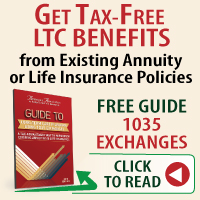What The Ratings Mean - Links To Rating Companies' Websites
* The A.M. Best Company: Tel: 904-439-2200
A.M. Best is one of the better known of the insurance rating companies. Here is an overview of what the A.M. Best rating system means. Because A.M. Best requires a licensing fee to post ratings, we recommend you request ratings from the insurance company or request them from a designated long term care insurance professional working with the American Association for Long Term Csre Insurance.
| A++ and A+ (Superior): | The company has demonstrated superior overall performance and has a very strong ability to meet its obligations to policyholders over a long period of time. |
|---|---|
| A and A- (Excellent): | The company has demonstrated excellent overall performance and has a strong ability to meet its obligations to policyholders over a long period of time. |
| B++ and B+ (Very Good): | The company has demonstrated very good overall performance and has a good ability to meet its obligations to policyholders over a long period of time. |
| B and B- (Adequate): | The company has an adequate overall performance and can meet its obligations to policyholders but may be vulnerable to unfavorable changes in underwriting or economic conditions. |
| C++ and C+ (Fair): | The company has demonstrated fair overall performance and can meet its current obligations to policyholders but is vulnerable to unfavorable changes in underwriting or economic conditions. |
| BC and C- (Marginal): | The company has demonstrated marginal overall performance. It can meet its current obligations to policyholders but is very vulnerable to unfavorable changes in underwriting or economic conditions. |
| D (Very Vulnerable): | The company has demonstrated poor overall performance. The company can meet its obligations to policyholders but is extremely vulnerable to unfavorable changes in underwriting or economic conditions. |
| E (Under State Supervision): | The company is under state insurance regulatory authority supervision, control or restraint, such as conservatorship or rehabilitation, but not including liquidation. |
| F (In Liquidation): | The company has been placed under an order of liquidation by a court of law, or its owners have voluntarily agreed to liquidate. Companies that voluntarily liquidate or dissolve their charters are generally not insolvent. |
Standard and Poor's:
Standard and Poor's rates the claims-paying ability of over 300 insurance organizations worldwide. Here is an overview of what the Standard and Poor's rating system means.
| AAA (Superior): | Superior financial security on an absolute and relative basis. Capacity to meet policyholder obligations is overwhelming under a variety of economic and underwriting conditions. |
|---|---|
| AA (Excellent): | Excellent financial security. Capacity to meet policyholder obligations is strongunder a variety of economic and underwriting conditions. |
| A (Good): | Good financial security but capacity to meet policyholder obligations is somewhat susectible to adverse economic and underwriting conditions. |
| BBB (Adequate): | Adequate financial security, but capacity to meet policyholder obligations is susceptible to adverse economic and underwriting conditions. |
| BB (Adequate): | Financial security may be adequate, but capacity to meet policyholder obligations , particularly with respect to long-term or "long-tail" policies, is vulnerable to adverse economic and underwriting conditions. |
| B (Vulnerable): | Vulnerable financial security. Currently able to meet policyholder obligations, but capacity to meet policyholder obligations is particularly vulnerable to adverse economic and underwriting conditions. |
| CCC (Extremely Vulnerable): | Extremely vulnerable financial security. Continued capacity to meet policyholder obligations is highly questionable unless favorable economic and underwriting conditions prevail. |
| NR (Not Rated): |
Moody's:
Moody's ratings rates the financial strength of investment vehicles and institutions including insurance companies. Here is an overview of what the Moody's rating system means. 1, 2 or 3 modifiers for each rating category. A 1 indicates that the insurance company ranks in the higher end of its rating category. The modifier 3 indicates that the company ranks in the lower end of its category.
| AAA (Exceptional): | Exceptional financial security. While the financial strength of these companies is likely to change, such changes as can be visualized are most unlikely to impair their fundamentally strong position. |
|---|---|
| AA (Excellent): | Excellent financial security, together with Aaa group, they constitute what are generally known as high-grade companies. They are rated lower than Aaa companies because their long-term risks appear somewhat larger. |
| A (Good): | Goodfinancial security. However, elements may be present that suggest a susecptibility to impairment sometime in their future. |
| BAA (Adequate): | Adequate financial security. However, certain protective elements may be lacking or may be characteristically unreliable over any great length of time. |
| BA (Questionable): | Questionable financial security. Often the ability of these companies to meet policyholder obligations may be very moderate and thereby not well safeguarded in the future. |
| B (Poor): | Poor financial security. Assurance of punctual payment of policyholder obligatiions over a long period of time is small. |
| CAA (Very Poor): | Very poor financial security. Company may be in default on their policyholder obligations or there may be present elements of danger with respect to punctual payment of policyholder obligations - claims. |
| CA (Extremely Poor): | Extremely poor financial security. Such companies are often in default on their policyholder obligations. |
| C (Lowest Rated Class): | The lowest rated class of insurance company. can be regarded as having extremely poor prospects of ever offering financial security. |
Get A Free Long-Term Care Insurance Quote Now - No Obligation
To receive a free no-obligation quote for long-term care insurance, click here: Free No-Obligation Long-Term Care Insurance Quote. .
If you are ready to see what coverage costs start by learning simple ways to get the best long term care insurance costs. Take three minutes to read two guides published by the American Association for Long Term Care Insurance. They appeared in issues of Kiplinger's Personal Finance magazine but you can read them online. No sign-in is required.
If you'd like to compare long term care insurance costs click on this link and request no-obligation information from one of the American Association for Long-Term Care Insurance's designated LTCi specialists. There is no obligation for the information and it is (of course) provided free of charge.




